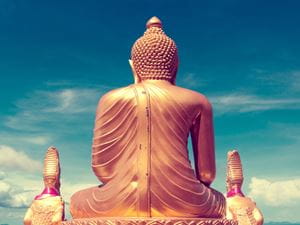
Shutterstock.com
Theravada Buddhism is sometimes called Hinayana Buddhism by Mahayana Buddhists. Hinayana means “little vehicle” and is a condescending name for the tradition. Theravada, on the other hand, means “the teachings of the elders.” This form of Buddhism is more prevalent in South East Asian countries such as Sri Lanka, Cambodia, Laos, Burma, Thailand and India. As well as being more prominent in the areas closer to the actual birthplace of the Buddha, Theravada Buddhism is older than Mahayana Buddhism and is seen by some as being closer to the original teachings of the Buddha.
Theravada emphasizes the concept of vibhajjavada or “the teaching of analysis.” This concept calls on Buddhists to gain insights into the wider world through their own personal experiences and knowledge. These are then examined through critical thinking and reasoning and weighed against what is stated in scriptures and by wise monks.
Buddhists in the Theravada tradition believe that all worldly phenomena have three properties: they are impermanent and transient; unsatisfactory; and there is nothing in them which is substantial, permanent or intrinsically, uniquely theirs. Everything can also be broken down into the two elements, material and non-material parts. The non-material element can then be broken down into four constituent parts: sensation, perception, mental formatives and consciousness.
When a person comes to understand and accept these ideas, they find that everything is “empty.” As such, there is no point to the selfish cravings that cause suffering, and an individual comes to end their suffering by following the Eight-Fold Path. This causes them to reach nirvana and become an arhat, a person who will not be reborn after this life is over but who will move on into eternal peace.
Mahayana Buddhism agrees with some of the basic elements of Theravada Buddhism but is noticeably different from the other school. Mahayana means “great vehicle” and has a number of smaller traditions within it, such as the Tantra school which forms the basis for several types of yoga, the Pure Land tradition which holds that salvation can only be found through absolute trust in Amitabha and the meditative tradition of Zen Buddhism.
According to Mahayana Buddhism, the only way to achieve enlightenment is to look inward. Mahayana Buddhists emphasize intuition over logic. As such, Mahayana Buddhists are more known for their meditation practices than Theravada Buddhists, though Theravada Buddhism does involve meditation as well. Mahayana Buddhism also places more emphasis on the bodhisattva path and states that people should aspire not just to enlighten themselves but to enlighten all beings. Unlike Theravada Buddhism which focuses on logic and insight to reach nirvana, extreme compassion is the vehicle by which Mahayana Buddhists reach enlightenment. Mahayana Buddhists aim to treat every being “like [their] mother who raised [them].”
Mahayana Buddhists also use different texts and scriptures than Theravada Buddhists. Theravada Buddhism emphasizes the Pali Canon in its original language. Mahayana Buddhism on the other hand focuses on sutras that are younger than the Pali Canon and favors Sanskrit. Many of the sutras that are best known to non-Buddhists, such as the Lotus Sutra and Diamond Sutra, are Mahayana sutras.
Given the differences between Mahayana and Theravada Buddhists, it is no surprise that the two schools celebrate different holidays. While there is some overlap, each school has festivals that are unique to that school. One such celebration is Theravada New Year. As the name implies, this festival is largely celebrated by Theravada Buddhists. Theravada New Year falls in the mid-to late spring while Mahayana New Year tends to fall around the turn of the year for the Gregorian calendar. Some Buddhists, however, do not celebrate either Theravada or Mahayana New Year but instead recognize the Chinese New Year.
Theravada New Year is a three day celebration surrounding a full moon. Celebrations and traditions vary from region to region, but many Buddhists use rituals that involve water and sand. Adherents may build sand hills to symbolize Mount Meru, the mountain at the center of the cosmos and home of the gods. Buddha statues are distributed to monks, and in Thailand and Laos, people pour water on each other and Buddha statues in equal measure. People once tossed dyes, pastes, flours and tapioca as well as water, but in recent years people have been discouraged from dumping anything but water or perfumed water on their neighbors. Some communities have colorful processions or build sand sculptures on the banks of rivers. Each grain of sand represents a wrongdoing, and when the sand is washed away by the river, the bad karma caused by the wrongdoing is erased as well.
Several South East Asian countries also celebrate Theravada New Year by buying captured fish and birds. These animals are then released into the wild to show compassion to all living beings and build good karma. Devotees are also expected to spend the festival days in deep, concentrated thought about the birth, enlightenment and death of the Buddha.
Buddhism is a major world religion and both Mahayana and Theravada Buddhists live on every continent that humans have settled. Theravada Buddhism has a smaller number of adherents than Mahayana Buddhism, but there are still more than 100 million Theravada Buddhists in the world. Many of them celebrate Theravada New Year in the spring and take part in the myriad of traditions surrounding the holiday. The traditions vary from place to place, but there is always an underlying theme of a fresh start, a chance to either wipe the slate clean the slate or to do better this year in order to do better in the next life.

